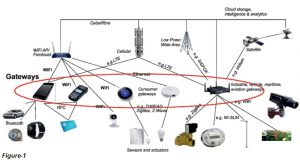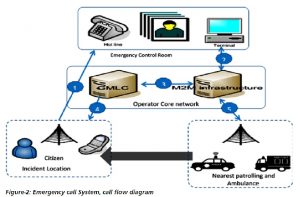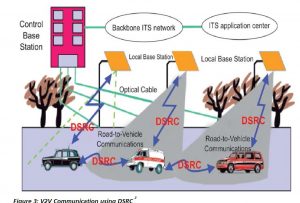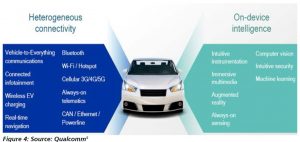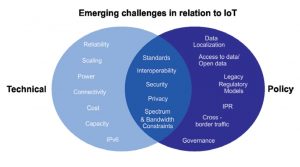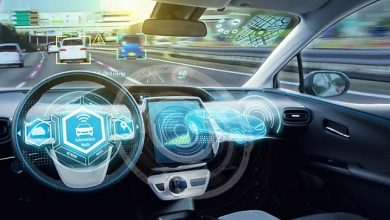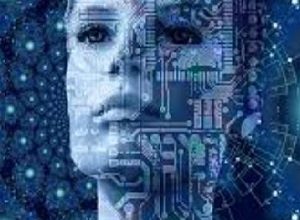M2M/ IoT in Automotive Sector
As per projection by GSMA (GSM Association) and Machina Research (World’s leading advisor on M2M, Internet of Things and Big Data), there may be around 24 billion connected devices in the world around 2020, with a business impact of around US $ 4.3 trillion. Later on CISCO / Ericsson / ITU projected this to be around 50 billion. Global projections vary from 24 Billion to 50 Billion connected devices by 2020. Such projections entice the industry to explore and tap a wide range of opportunities that the M2M (Machine to Machine) communication / Internet of Things (IoT) concept offers, enabling novel business cases, enhanced workflow, efficiency and improved quality of life. These devices may be in various sectors such as Safety & Surveillance, Automotive, Power, Health care, Smart homes, Intelligent buildings, Environment monitoring and pollution control, Water management, Waste management, Agriculture etc.
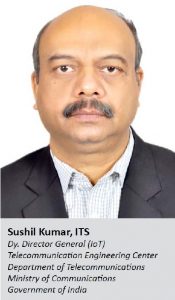 In India, there may be around 5 billion connected devices by 2022 as per NDCP 2018.
In India, there may be around 5 billion connected devices by 2022 as per NDCP 2018.
Power sector (smart metering and smart grid) and Automotive Sector may have major deployment of M2M devices.
1. Problems of Major Indian cities: -India with a population of around 1.3 billion is having approx. 33% living in urban areas and 67% in rural areas. As per projections, around 25 persons are migrating per minute from rural areas to urban areas in search of jobs, better education and healthcare.
There are problems of Transportation, pollution, health care, Electricity, drinking water, waste management etc. To resolve the complexity of these issues, M2M/ IoT along with ICT may be used to get the data in real time.
2. Issues related to Automotive sector: -Automotive sector is the back bone of any country. In India due to rapid rise in number of vehicles with respect to existing infrastructure and slow rate of development in infrastructure sector recent studies show that India faces
• An average Indian spends about 90 minutes a day travelling in major cities, with an average speed of 10 – 15 km/hr on some major roads,
• Due to congestion, slow speed of freight and waiting time at toll plazas, there is a loss of approx. Rs. 600bn (US $10.8bn) per annum,
• In India, around 5 lakhs road accidents happen, causing a loss of around $20 billion, with 6 lakhs people injured and 1.5 lakhs killed,
• Every year, nearly 36,000 vehicles are stolen, which amount to Rs. 115 crore with only about 14,500 getting traced, often in un-roadworthy conditions, with many components missing,
• Vehicles are the major contributor to AIR pollution.
The rapidly increasing vehicle population in India puts a heavy demand on traffic management in metropolitan cities and other towns. Intelligent Transportation System is an established route to address this and minimize traffic problems.
Traffic jams cost huge loss in terms of time, money & pollution. Widening of roads and creating more lanes cannotbe the long term sustainable solution as the space is limited.
Use of M2M / IoT technology along with ICT infrastructure can help / solve the jams occurring to a large extent. With limitation for growth infrastructure there is a strong need to depend on technology (IoT/M2M) to address challenges, currently faced by the industry. M2M enabled transportation system include telematics and all types of communications in vehicles, between vehicle and citizens/Authorities (car to application), between vehicles (e.g. car-to-car), and between vehicles and fixed locations (e.g. car-to-infrastructure).
3. M2MCommunication/ Internet of Things (IoT)
3.1. M2MCommunication
It refers to the technologies that allow wired / wireless system to communicate with the devices of same ability. M2M uses a device (sensor, meter etc.) to capture an ‘event’ (motion, video, location, speed etc.), which is relayed through a network (wireless, wired or hybrid) to an application (software program), that translates the captured event into meaningful information.
The enabling technologies for M2M communication are sensor networks, RFID, mobile Internet, wired & wireless communication network, IPv4 / IPv6, etc.
3.2. Internet of things (IOT)
ITU-T in its Recommendation ITU-T Y.2060 (06/2012) has defined Internet of Things (IoT), as a global infrastructure for the information society, enabling advanced services by interconnecting (physical and virtual) things based on existing and evolving interoperable information and communication technologies.
IoT will be having a heterogeneous network, having IP and non IP devices connected through IP Gateways. Gateways will be connected to IoT Platform. Communication technology is an important segment of the IoT domain as the data is required to be transmitted and received in time. If the data is not transmitted in time, it has got no value. A typical network having various communication technologies and Gateways have been shown in Figure – 1.
M2M isa subset of IoT. IoT is a more encompassing phenomenon because it also includes Human-to-Machine communication (H2M). With IoT, the communication is extended via Internet among all the things that surround us.
4. Various use cases in Automotive sector: -There may be a large no. of use cases depending upon the local requirements. Important use cases are :
- Vehicle tracking,
- e-call (911 in USA and 112 in Europe),
- V2V and V2I applications,
- Traffic control,
- Navigation, Infotainment,
- Fleet management,
- Asset tracking,
- Manufacturing and logistics,
- Intelligent transport System,
- Waste management,
- Water distribution,
- Smart Parking
- School bus tracking
A number of use cases have been described in detail in the Technical Report on M2M enablement in Intelligent Transport System .
Government of India has already mandated to install GPS/GRPS devices with video camera and panic button in all public transport with cellular connectivity to police stations for woman safety in public transports.
RFID based Electronic Toll Collection devices are being deployed in India on various National Highways / Expressways, in the sub Ghz band 865 MHz – 867 MHz band.
In India 112 has been adopted as a common emergency number in line with ITU-T Recommendation E.161.1 (09/2008) “Guidelines to select emergency numbers for public telecommunication network”.All existing helpline numbers such as 100- Police, 101- Fire, 102/ 108- Ambulance service will be migrated to 112.
M2M communication / IoT will make the verticals smart by providing the data in real time and will enable to take the decision for planning, operation and other related activities.
5. Enabling technologies for M2M / IoT: -The enabling technologies for M2M / IoT are sensor networks, RFID, mobile Internet, Location Based Services (LBS), Lab-on-a-Chip (LOC), Augmented Reality (AR), Artificial intelligence, wired & wireless communication network, IPv4 / IPv6 etc.
5.1. Communication technologies in M2M/ IoT domain: – Communication technologies will play a very important role in the IoT domain as timely transmission of data is required.
Data may be from few bytes (meter reading, fire alerts, temperature etc) to several MBs (video from a camera). Data may be in the form of bursts. There may be different types of communication technologies covering few centimeters to several kilometers and will be decided depending upon the use case requirement.
In Personal area network (PAN)/ Home area network (HAN) / Local area network (LAN)/ Field area network (FAN), low power wireless communication technologies such as Wi-Fi, ZigBee, 6LoWPAN, Bluetooth Low Energy (BLE), Z-wave etc. may be used to connect the devices with the M2M gateway. GSM 3G/ 4G or fixed line broadband / FTTH may be used for connecting M2M gateway to the server.
Low Power wide area network (LPWAN) technologies: – LPWAN technologies have been developed to carry a very small data to a large distance. It covers 2-3 Km in city (dense) areas and 12-15 Km in rural (open) areas. Expected battery life is around 10 years.
Use cases: Smart metering, Smart farming (transmitting Soil testing data), Smart bin, transmitting pollution sensor data etc.
In non-cellular domain, LPWAN technologies such as LoRa and Sigfox are being deployed across the globe. LoRa and Sigfox networks are deployed in delicensed sub GHz frequency band and in India it is 865-867 MHz.
In cellular domain, 3GPP has already released specifications in its Release 13 and onwards for LPWAN services, which may co-exist with the existing cellular network deployment.
Three variants in LPWAN technologies in cellular domain are EC-GSM, NB-IoT and LTE MTC. Cellular operators can enable LPWAN services in the existing GSM / LTE networks by upgrading the software. Trials have been done and the commercial offerings are also available in a number of countries namely South Korea, Europe, USA etc.
TEC had released a Technical Report on Communication technologies in M2M/ IoT domain .
5.2. M2M SIM: -The normal SIM card is not suitable for harsh conditions of vehicles like vibrations, temperature, and humidity. GSMA has created specifications for embedded M2M SIM, with Over-the-Air (OTA) provisioning. Temperature variation range is from -40 degree to +125 degree Celsius. Embedded SIM technology offers big opportunities for auto manufacturers as the lifecycle of an eSIM is, around 10-15 years.
International standards for eSIM have evolved. Embedded SIM will be quite useful for vehicle tracking services. Embedded SIM may have the subscription from more than one telecom service providers (up to five) and switching is possible from one TSP to another remotely or non-availability of signal from the main TSP.
Embedded SIM will be the game changer in the IoT domain.
5.3. DSRC (Dedicated Short Range Communication):- This technology was developed in USA around 20 years back. It isbased on IEEE 802.11p WLAN standards, called as Wireless Access in Vehicular Environment (WAVE). It is working in the frequency range 5.850 -5.925 GHz.FCC has allocated 75 MHz spectrum in the 5.9 GHz band and European Telecommunications Standards Institute (ETSI) has identified of 30 MHz spectrum in the 5.9 GHz band for ITS.It also supports low latency, Vehicle to Vehicle (V2V) and Vehicle to Infrastructure (V2I) communication.
Its main uses are Vehicle Safety service, Commercial transaction via cars, Toll collection, Traffic management etc.
This technology is being used in USA, Europe, Japan, Korea and Singapore etc.
Details about the M2M SIM are available in the technical report released in TEC onV2V/ V2I Radio Spectrum and Embedded SIM .
5.4. Cellular V2x (Vehicle to everything): – V2X comprises vehicle to vehicle (V2V), vehicle to infrastructure (V2I), Vehicle to Pedestrian (V2P) and Vehicle to Network (V2N). 3GPP in its Release 14 has provided the specifications for cellular V2X which provides improvements over 802.11p / DSRC technology for active safety use cases and beyond. 5G roadmap will improve the connected vehicle segment built on cellular V2X. Connected vehicle requires heterogeneous connectivity and on device intelligence as shown.
5.5. 5G Technology: 5G will provide Enhanced mobile broadband with peak data rate of 10 Gbps, Mission critical services (Ultra reliable & low latency communication (URLLC) with RAN latency <1ms and Massive M2M/ IoT services. URLLC will be quite useful for self-driving vehicles, drones, Robotic surgery and V2V communication. Various applications of 5G have been shown.
The standards for 5G will be frozen in 2020 and may take further 2-3 years for deployment. However pre standards based deployment are in progress in few cities of USA, South Korea, Japan, China etc. 5G deployment is also expected in India around 2022. Key spectrum bands under discussion for 5G are as: • 700 MHz in low range. • 3.4-3.6 GHz is globally allocated. Some countries have gone for 3.3- 3.4 GHz. Europe is planning 3.4 – 3.8 GHz range. • 24-27.5 GHz, 27.5-29.5 GHz and 37-43.5 GHz in high range. • 71 – 76 GHz and 81-86 GHz range. • 24 – 86 GHz range is under study for WRC 19.
5.6. High end vehicles are using a large number of sensors for different applications such as motion sensors, weather sensors, parking sensors, Tyre pressure sensor, road status, temperature sensors fuel sensors, temperature sensors, door sensorsetc.
5.7. Geographic Information System (GIS): GIS plays an important role in creating maps, model, query, and analyse large quantities of data within a single database according to their location. It is a powerful tool to create maps, integrate information, visualize scenarios, present powerful ideas, and develop effective solutions.
5.8. High speed internet services on fixed line broadband connection as well as on mobiles (Smart phones) are required for transmission of data from gateway to headend system / cloud. Smart phones may work as a gateway for the devices working on BLE / Wi-Fi. Clouds may share the data on open APIs. Edge computing and Artificial intelligence will further add a value.
5.9. Big data analytics to create intelligence: – A huge amount of data will be generated from the sensors/ devices. Raw data has got no meaning. Big data analytics may be used to create intelligence. Intelligence may be used in various planning and operational activities.
6. Connected Cars (Vehicles) are growing rapidly as the industry moves towards deploying new technologies that benefit the connected car ecosystem – vehicle manufacturer, vehicle user, vehicle owner, fleet manager, insurer (insurance based on driving behavioral pattern), service agency and the Government – to name a few.
7. Network quality of Service (QoS) requirement M2M communication is different from the voice communication as size of data in M2M may vary from few bytes ( meter reading) to several MBs ( surveillance video in). In Automotive sector depending upon the use case data size will vary. But the umbrella coverage is required for the vehicles in movement. M2M services requirement are • Timely transmission is of utmost important. • Communication network is required to be more reliable with low latency.
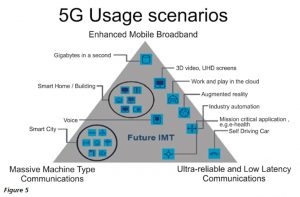 8. Challenges related with the technology and policy:-A number of challenges related to policy and technology as shown in figure-5 are required to be resolved for the fast and smooth growth of this domain.Due to lack of standardization and interoperable technologies, Industries are working in silos and on proprietary solutions. There should be interoperability at device, Network and application levels. Figure-6: Emerging challenges of ioT domain, [2] Technologies for sustainability / long life batteries is required for sensors.There is a need to generate indigenous IPR for creation of standards and further contribution in global SDOs. Reliable connectivity, localization of data in cross border traffic, spectrum requirement for low power devices and slow deployment of IPv6 are some of the challenges to be resolved.
8. Challenges related with the technology and policy:-A number of challenges related to policy and technology as shown in figure-5 are required to be resolved for the fast and smooth growth of this domain.Due to lack of standardization and interoperable technologies, Industries are working in silos and on proprietary solutions. There should be interoperability at device, Network and application levels. Figure-6: Emerging challenges of ioT domain, [2] Technologies for sustainability / long life batteries is required for sensors.There is a need to generate indigenous IPR for creation of standards and further contribution in global SDOs. Reliable connectivity, localization of data in cross border traffic, spectrum requirement for low power devices and slow deployment of IPv6 are some of the challenges to be resolved.
9. Standardization at Global level:-A number of international organizations are working on the standardization in IoT domain namely ITU, IES, ISO, OneM2M, 3GPP, ETSI, IEEE, Continua Health alliance etc.
9.1.International Telecommunication Union (ITU): ITU is having around 193 member states, 700 industries and 200 academia as members. Any standard approved / adopted by ITU is generally accepted globally. In June 2015, ITU-T has created a new Study Group (SG)-20 to work on IoT and its applications including Smart Cities and communities ITU –T SG-20 has approved / consented a number of standards in the form of technical documents. National working Group (NWG) – 20 was created in TEC in September 2015, to submit contributions from India, in ITU-T SG-20. Details of TEC participation in ITU-T SG-20 has been given in para 8.
9.2. OneM2M: – ETSI (Europe), TTC, ARIB (Japan), ATIS, TIA (USA), TTA (Korea) CCSA (China) had come together and created a partnership project OneM2M, to avoid creation of competing M2M standards. They are working to create standards for the common service layer. From India, TSDSI is the member of OneM2M. OneM2M has released first set of specifications in Jan 2015 and its IInd release in March 2016. OneM2M has submitted its technical specifications in ITU-T SG-20 for approval / adoption. 10. Standardization work in Telecommunication Engineering Center (TEC), DoT, India: – TEC formed eleven multi-stake holders working groups in the last 2- 3 years to work in M2M and IoT domain. Eight working groups are in the verticals namely Power, Health, Safety and Surveillance, Intelligent Transport Systems, Smart Cities, Smart Homes, Smart Village & Agriculture and Environment & Pollution control. Three working groups are in the horizontal area common to all the verticals, namely M2M Gateway & Architecture, Security in IoT domain and Communication Technologies in M2M/ IoT domain. Eleven technical reports have been released so far and available on TEC website (www.tec.gov.in/technical-reports/).These technical reports may be quite useful in preparing eco system for the ioT domain and also for Smart Cities.
i. M2M Enablement in Intelligent Transport System ii. M2M Enablement in Remote Health Management iii. M2M Enablement in Safety & Surveillance Systems iv. M2M Gateway & Architecture. v. M2M Number resource requirement and options vi. V2V / V2I Radio Communication and Embedded SIM vii. Spectrum requirements for PLC and Low Power RF Communications. viii. ICT Deployments and strategies for India’s smart cities: A curtain raiser ix. M2M/ IoT Enablement in Smart Homes x. Communication Technologies in M2M / IoT domain Technical Reports mentioned at ii and vii are important and related to the IoT development for Automotive sector. TR at v, vii, viii and xi serves across all verticals. 10.1. Actionable points emerged from the technical reports (TRs): 1. Based on TR and consultations with all the stake holders, TEC proposed 13 digit M2M Numbering plan for SIM based devices/ Gateways which will co-exist with existing 10 digit numbering scheme being used for mobile phones. DoT has approved this scheme and issued orders to all the TSPs for implementation. Five codes of 3 digit each (559, 575, 576, 579 and 597) have been allotted as a M2M identifier. 2. Embedded SIM : Based on TR, IR has been prepared in TEC. DoT has approved the use of Embedded SIM with OTA provisioning in May 2018. Ministry of Road Transport and Highways, India has already included Embedded SIM with OTA provisioning in AIS140 standard which specifies the conditions and specifications for the use of connected devices in vehicles . 3. Spectrum requirement for Low power RF communications in Sub GHz band. 4. Any device / Gateway having direct connectivity with PSTN / PLMN should have static IP (IPv6 or dual stack). BIS has mandated IPv6 for Smart meters to be connected on Cellular technologies, IS16444. 5. Licensing for LPWAN on non-cellular technologies, providing public services. 6. Common service layer requirement at the platforms, important for data sharing, Security and interoperability. 10.2. International collaboration: – Based on the technical reports released in TEC, contributions have been prepared and submitted in ITU-T SG-20 meetings time to time. Template for use cases for submission in ITU-T SG-20 was approved based on Indian contribution in July 2016. Work item “Y.IoT-use cases” was also created in ITU-T SG-20, based on Indian contribution for submitting use cases. Contributions submitted from India and related to Automotive sector are as given below: I. Vehicle emergency call system for automotive road safety II. Digitization and automation of Vehicle Tracking, Safety, Conformance, Registration and Transfer via the application of e-SIM and Digital Identity 10.3. Device testing and Certification: -M2M devices need to conform to EMI/ EMC, safety, security standards, technical protocol, IPv6, SAR etc based on international standards and best practices. Essential requirements (ERs) have been prepared under MTCTE (mandatory testing and certification of telecom equipment) scheme, for a no. of smart devices such as Location Tracking device, Smart Meters, Smart watch, IoT Gateway, POS machines, Smart security camera and feedback device etc. and are available on TEC website. MTCTE is being implemented in phased manner from 1st Jan 2019. 11. Conclusion:-M2M/ IoT will play a big role in making the automotive sector smart, which in turn will help in resolving a number of issues and improving the quality of life. Some servicessuch as Vehicle tracking, geo fencing etc. are being provided in silos by the various device manufacturers / application providers. For large proliferation of the services and also to have economies of scale, standardization at device, network and application level is required. With the large scale deployment of LTE services and 5G to come in near future, V2V and V2I servicesas a part of Intelligent transport system may become a reality. Connected vehicle scenario may have bunch of technologies such as Cellular, WiFi, DSRC etc. depending upon the availability of eco-system.
References: 1. TEC Technical Reports are available on TEC web link www.tec.gov.in/technical-reports 2. Harnessing the Internet of Things for Global development by CISCO and ITU.https://www.itu.int/en/action/broadband/Documents/Harnessing-IoT-Global-Development.pdf

